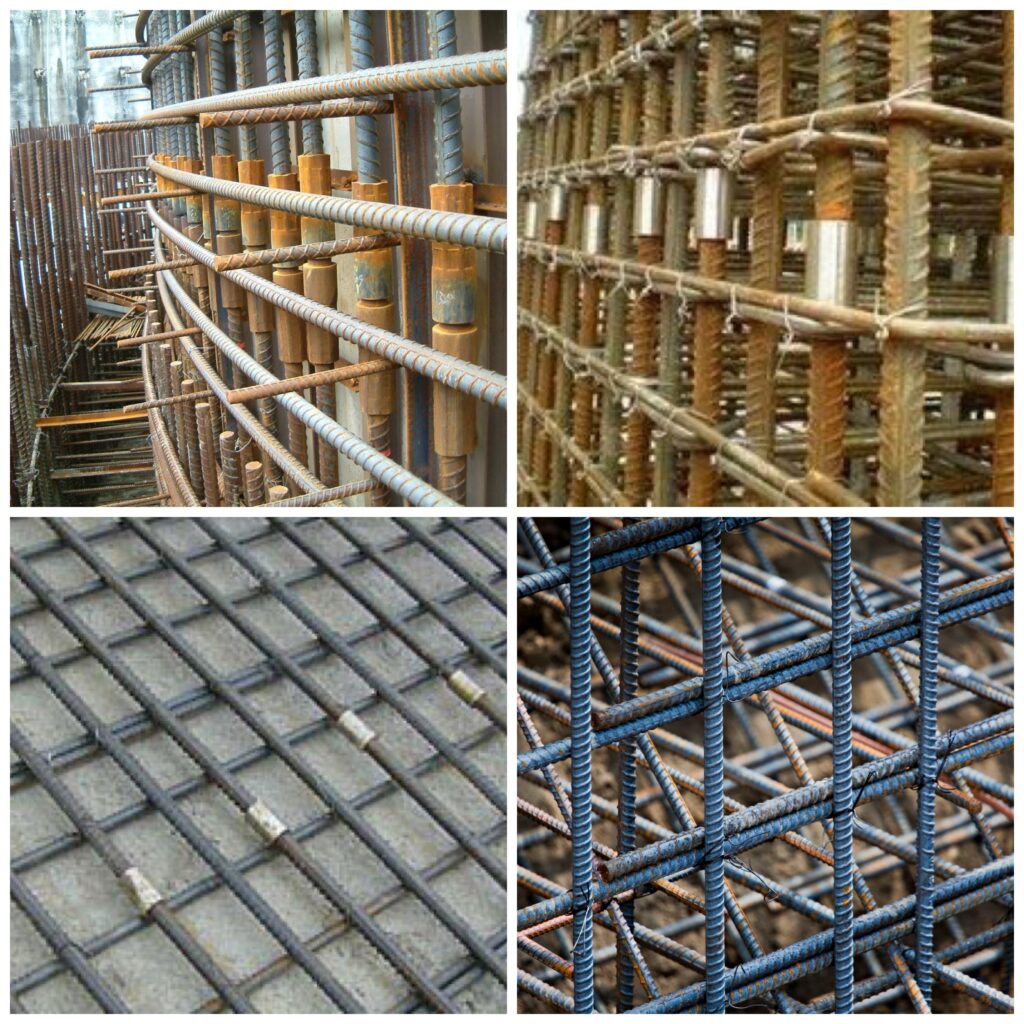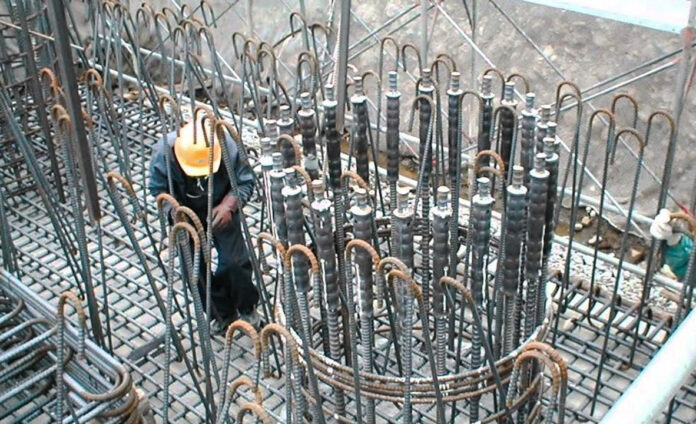Mechanical splices are used to establish a mechanical connection between two pieces of reinforcing steel in concrete construction for joining reinforcing bars. The mechanical splicing system aligns and secures the joined rebar ends in an in-line connection suitable to meet appropriate splice requirements.
Mechanical splices are being adopted in project sites due to their flexibility of use in congested reinforcement places at construction joints. These connections are also more reliable than the lap systems because they do not depend on the concrete for load transfer. The splices also allow structural designers to achieve an ideal balance of steel and concrete by eliminating the additional rebar lap zone by meeting building code requirements in many areas. In seismic prone zones, these splices provide structural engineers the ability to design and build concrete structures that meet or exceed today’s stringent construction codes and federal regulations regarding seismic frame construction.
Advantages of mechanical splices for concrete rebar
- Maintains load path continuity of the reinforcement, independent of the condition or existence of the concrete.
- Does not rely on the concrete for load transfer and therefore maintains structural integrity.
- As mechanical splices do not overlap, less rebar is used, reducing some of the material costs.
- It reduces the rebar congestion by decreasing the rebar in the lap zone and simplifying bar placement
- Using mechanical splices allows the option of larger diameter rebar in a smaller column while minimizing congestion
- Decrease the possibility of pockets and voids in the concrete
- Provides higher performance than typical design lengths for lap splices
- Allows the structural designers to achieve an ideal balance of steel and concrete by eliminating the additional rebar in the lap zone
- Eliminates lap calculations
- Eliminate the cost of breaking away massive amounts of concrete.
- Faster installation
- Reduces crane use
- Limits drilling of formwork

Different types of mechanical splices
Based on the category of ‘tension- compression’, ‘compression only’ and ‘tension only’ there are different types of mechanical splices available. Each of them is explained below.
Coupler for Thread-Deformed Bar- This type of deformed bars comes with special bars with thread-like rolled deformations. These are assembled with lock nuts and threaded couplers, then the nuts are tightened to the specified torque.
Upset Straight Thread Coupler- This type of coupler is used to produce a full-length mechanical joint between reinforcing bars with upsetting ends. It can connect rebars of the same or different diameters laterally, vertically and slantingly. The coupler consists of a coupler with internal straight threads at each end that joins two upset end reinforcing bars with matching external threads.
Non- upset thread Coupler- This type of coupler consists of internal straight threads at each end that join two reinforcing bars with matching external threads. It is used to reduce the net cross-sectional area of the reinforcing bar. This type of splice comes in three pieces, the two bar ends and the internally threaded coupler.
Cold-Swaged Threaded Coupler- This type of coupler is made of seamless steel sleeves that are placed at the end of reinforcing bars. These are deformed onto the reinforcing bar profile to produce mechanical interlock. This consists of pre-threaded components, which are swaged onto the reinforcing bars using a swaging press with special dyes. Splicing of the bars is completed by installing one pre-threaded component into the other.
Taper-Threaded Coupler- This type of coupler is designed for applications that require the joining of reinforcing bars. The compact design of each coupler ensures suitability for use in confined situations where space is restricted or where the loss of cover must be minimised. The couplers are normally supplied fitted to the end of the threaded bar, requiring only the engagement and tightening of the adjoining bar on site.
Straight Threaded Coupler with Upset Rebar Ends- This type of coupler consists of forming heads on the ends of the bars that are connected using a hydraulic machine. It is designed to fit between closely-spaced bars.
Grout-Filled Coupling Sleeve- This type of sleeve is filled with grout that provides a mechanical bond between rebar deformations and grooves on the inside of the sleeve. This is filled with a cement-based, non-shrink, high-early strength grout. The range comprises two standard coupler types: Full-grout sleeves and Half-grout sleeves.
Combo Grout-Filled/Threaded Sleeve– This type of sleeve is designed for the connection of precast elements. Each sleeve features a threaded end that is used for the connection to reinforcement at the precast element and a wide cavity to perform a grout connection at site. The wide mouth opening of the sleeve allows for minor bar misalignment during erection. The wide mouth also allows for transitioning between different bar sizes.
Metal-filled coupling Sleeve- This type of sleeve is placed end to end in the metal sleeve with a molten metal filler in the tap hole. The filler material flows between the bars and the sleeve, solidifying in the deformations of the rebar and the internal ribs of the sleeve, forming a mechanical interlock.
Cold-Swaged Coupling Sleeve- This type of sleeve is used for the connection of ribbed rebar. It is made of carbon structural steel and can connect reinforcing bars with a diameter of 16 to 40 mm. The sleeve uses a hydraulic swaging press with a special dye to deform the sleeve around the ends of the spliced reinforcing bars. This produces a positive mechanical interlock with the reinforcing bars.
Shear Screw Coupling Sleeve- This type of sleeve consists of a coupling sleeve with shear head screws which are designed to shear off at a specified torque.
Extruded Coupling Sleeve- This is a cold extruding coupling sleeve that connects two reinforcing bars by extruding a coupler onto the reinforcing bars.
Coupling Sleeve with Double Wedge- This type of sleeve is made of a ductile iron sleeve that consists of two internal wedges. Two series of cone-pointed screws are arranged along the sleeve length.
Coupling Sleeve with Shear Bolt/Wedge- This type of sleeve is designed to deliver a quick and simple method of splicing of 12 mm – 20 mm bar. Installation is made in seconds by overlapping the rebar in the steel sleeve and driving the wedge pin between the bars with a portable hydraulic hand tool. The coupling sleeve is oval in cross-section permitting the overlapping of two reinforcing bars of the same diameter in the sleeve.
Dowel Bar Mechanical Splice- This is a two-piece, upsized parallel threaded, mechanical splice that eliminates protruding dowels. No welding or machining is required for the installation of this splice and the threading operation does not reduce the nominal cross-sectional area of the bar.
Compression-only Mechanical Splice– This type of splice can resist compression stress merely. The compressive stress is transferred by vertical bearing from one bar to another one. Compression only mechanical splices can be used when tension stress does not occur.
Applications of mechanical splices

- Tunnels
- Bridges
- Commercial buildings
- High-rise buildings
- Subway
- Airports and many more
Conclusion
Working with small diameter reinforcing bars may require the use of larger column dimensions to accommodate a greater quantity of bars. Using mechanical splices allows the structural engineers the option of using larger diameter rebars in the smaller column while minimizing congestion. All the advantages are discussed above and there are many types of mechanical splices available in the market, choose the right one as per project needs. Go for experienced manufacturers.


